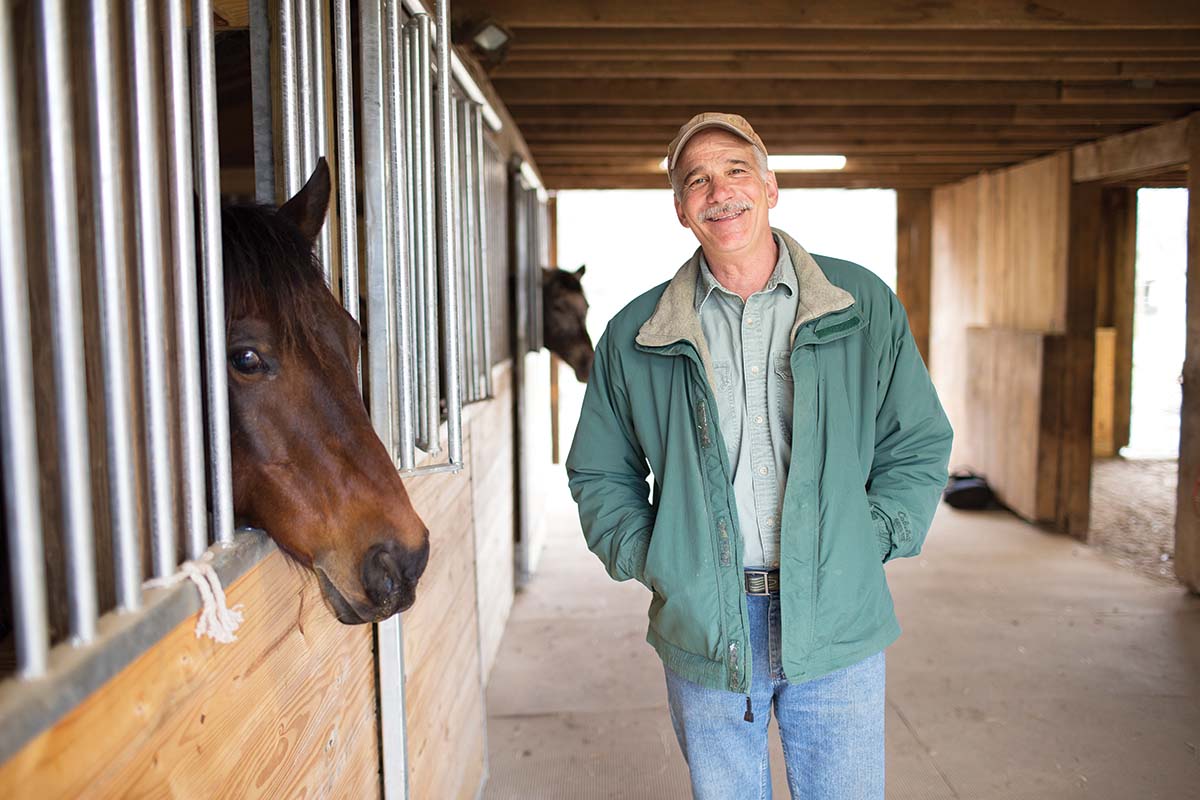
Earlier in the spring, flower beds on Parker Andes’ property in Mills River were still bare. There was a lot of mud and manure, but also bamboo stakes in the ground to show where a few large hollies would be planted, and a hose arranged to suggest a garden’s potential layout. Andes had plans.
The Director of Horticulture at Biltmore Estate, he oversees one of the grandest landscapes around, visited by some 1.4 million people every year. Not surprisingly, his vision for his own yard involves some complicated aesthetics.
“Where do you see it most [from inside]?” Andes asks rhetorically. It’s not just about planting in sun or shade, but about enjoying the shrubs and trees when they’re not being cultivated: “How does it look from all the windows in the house?”
He’s had some time to think about it. The horticulturist and his wife, Alice, moved into their new three-bedroom home last November, after eight months of construction during which they slept in the driveway in a used camper. Since then, Andes has redone the inside of a small stable for Alice’s horses, adding new fencing for the animals and clearing a portion of the five-acre property around a small pond. Inside the traditional but open-concept home, the couple display black-and-white photos of vintage Asheville and crafts that include local pottery by Judi Harwood and a vase that incorporates hair from one of their horses — a gift from their daughter Carol.
At home, Andes has done much of his own labor, but at work he has a staff of more than 50 employees to help groom and cultivate the public spaces and flower gardens created by Frederick Law Olmsted, the so-called “father of landscape architecture,” born 198 years ago on April 26.
How did you land at Biltmore?
I knew the gardeners at Biltmore from professional conferences. Early in 2000, I saw that there was a job open at Biltmore, but I was in Georgia at the time, at a place called Callaway Gardens, and I had a big project going on. Later that summer I came to Asheville for a garden conference at Biltmore and I saw the gardeners from Biltmore and said, ‘Who got that job?’ And they said, ‘Nobody yet, are you interested?’ I was like, ‘I might be.’ So two months later I was working here. It was meant to be, even if I wasn’t going to be too aggressive with it.
How did you become interested in horticulture?
My father was always very into plants. He was a professor of education and administration at the University of West Virginia and he was also a Southern Baptist minister. I had friends from high school that were in the horticulture program, and, I say this kind of flippantly, there were some cute hippie girls that were in horticulture. I took a couple of courses and it clicked.
What does your job entail?
My job is leading the group of gardeners, garden managers, and supervisors and setting priorities. I get to enjoy their work. That is the biggest part of my job — I get to walk through the gardens and enjoy what people do. Now I have a challenge, because I also see a lot of what needs to be done. I work with all of the landscapes and gardens throughout the property, from the front entrance to the parking lots to the main gardens. There’s always something, and that’s one of the things I like about Biltmore. The historic part grabs you and holds you. It’s a world-famous landscape that we’re responsible for.
What do you get asked the most by visitors?
Oh, “What’s in bloom?” is the biggest thing, and “When’s the best time to visit the garden?” Those are the two big questions. Guests, especially if they’ve been before, get a sort of emotional attachment to the gardens. “When is the wisteria in bloom?” “When’s the best time to see the roses?” Visitors have these personal favorites.
What’s your own favorite time of year?
Probably my favorite time to walk through the gardens is on cool mornings towards the end of summer and the first week or two of September, because the gardens are at their lushest and fullest.
How many tulips did you plant this spring?
The last invoices [show] about 120,000 bulbs throughout the estate. There’ll be over 80,000 tulips in the wall garden. One of the challenges that we have is that a tulip has a peak display of about seven days. What we’ve done is we plant a progression of three blooms in every hole. We do early tulip or daffodil. Then we do a midseason tulip and we do a late-season tulip, all on the same hole. If you come at different times, you will see color progressions. And that’s one of the things the staff really spends a lot of time on. You want the right color progression, because they overlap each other, and the heights are different. It takes a lot of planning, and then everything comes out. Everything comes out and you do it again — and again and again and again.
Any bulbs at home?
Daffodils and alliums are about it. I’m actually into simplification. Most of my color will come from flowering shrubs and smaller flowering trees. I’m planting disease-resistant roses that can produce some flowers for cutting, evergreen and deciduous azaleas, rhododendrons, camellias. … Alice loves Shasta daisies and red Monarda [bee balm], so I’m doing those for her. I do not have a show garden. I keep any needed garden maintenance to a minimum, so I have time to fish.
